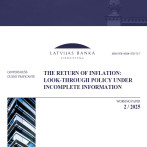The low annual inflation determined by factors from previous periods
The annual inflation in Mach 2013 remained at a low level (0.2%), with consumer prices undergoing a seasonal rise of 0.5% month-on-month. That the annual inflation remained so low was rather determined by the dynamic of particular factors from earlier (including base) periods instead of new ones.
First, we should note the oil prices, which reached their local maximum in March of last year and impacted fuel prices accordingly. In the first three months of this year, the average oil price was lower and in March even dropped slightly month-on-month, thus bringing down the price of fuel by 1.3%.
Second, the natural gas tariffs for households and those producers of thermal energy that use natural gas, which were gradually reduced in January and February, remained at a lower level also in March. Moreover, they kept the annual inflation level low accordingly.
In March of this year, the average consumer price level mostly rose under the impact of the seasonal wearing apparel and footwear prices. In this group of goods, the price rise was quite high/notable (+7.4%), raising the annual inflation as well. The seasonal rise in vegetable and potato prices meanwhile had only a slight impact on changes in y-o-y inflation.
The annual inflation is unlikely to drop significantly in the coming months. The favourable influence of the base period could still be felt somewhat in April, since during the Easter period (in part in March and especially in April) a very rapid rise in egg prices was observed as a result of the “unsuitable cage” scandal in several European countries. Later the prices dropped and this year they kept dropping even during the holiday period, despite the rather high prices of corn-derived feed prices.
The world food prices are also currently exempt from steep hikes because of the "second winter" in Europe: this is indicated by the first week of April data on the Eurex Agriculture future prices (with both very close and longer maturities) that are lower than in March.
Other factors, however, could operate toward a rise: e.g., the indirect impact of the electrical power price, which was raised for industrial consumers in April as a result of the increase in the mandatory procurement component. In May and June, the favourable impact of the oil price dynamic will shrink because of the base (in May and June of 2012, the oil and fuel prices dropped substantially).
The discussions on several plans for thermal energy tariffs have been dragging on. Thus, e.g., in Jūrmala, the reduced tariffs could have taken effect as early as February. Elsewhere, however, it is still possible to receive a favourable decision from the Public Utilities Regulatory Committee before the tariffs come into effect and thus, if a similar 9-month average mazout price stays the same by the middle of the year, a small drop in consumer prices can be expected.
Since a decline has been observed in several of Latvia’s export markets and export income is rising more slowly than in 2012, a rapid rise in the population’s purchasing power cannot be expected. Thus a demand-side pressure on inflation will not resume in the near future and the average annual inflation will remain low; however, as the impact of base factors abates, the annual inflation level will gradually reach about 2% in the second half of the year.
Textual error
«… …»






